Archives / Past Events
Past Events
School Tour
February 20, 2024
3:00 PM – 4:30 PM EDT
Meet at Middle School Entrance Lobby
Buckley Elementary
250 Vernon St, Manchester CT 06042
Parking on-site in parking lot
Tour Guides: Ben Kleine-Kracht and/or Jess Farber as well as Randall Luther
View Project PDF »
This course focuses on the continued lessons learned in over fifteen years of zero energy design
illustrated through case studies from various recent projects. The evolution of building systems and
their effect on the path to zero energy reveal best practices for Zero Energy building design and
operations, valuable information the attendees can apply to their future project designs.
Learning Objectives:
- Demonstrate an understanding of the design issues affecting Zero Energy buildings.
- Discuss the impact that human behavior has on Zero Energy design.
- Define a model for cost effective Zero Energy building design.
- Apply best practices to Zero Energy building design and operations.
Project Team:
Architect of Record: TSKP
Electrical Engineer: CMTA
Contractor: O&G
Owner: Town of Manchester
Member: $10 |
Non-Member $20
Member Public: Free |
Non-member Public: $10
Event Sponsor: $250
Chapter Event
June 15, 2023
3:30 – 5:00 PM
Location: South High Community School
170 Apricot St, Worcester MA 01603
Putting Community at the Center of School Design
South High Community School is a large urban public school serving 1,420 students in grades 9-12. The school serves a socio-economically diverse population in the city, including students struggling with food insecurity and homelessness. With large immigrant and refugee populations in surrounding neighborhoods, there are many English language learners at the school.
Designing a new school provided an opportunity to better address the many needs of the community that the school had already been successfully tackling. In addition to the traditional academic and core space, the school integrated a health clinic, food pantry, childcare center, and student-led nonprofit organization Andy’s Attic, which distributes donated clothing, shoes, backpacks and school supplies to students and their families.
Community is at the heart of the school’s culture, so one important design element was a lobby project to capture and celebrate that culture. The design came about through a student-led collaborative process with teachers and staff, architects and designers, and key members of the local community. The initial concept was to express the “community” in South High Community School through multiple media, inclusive of many representative diverse perspectives and voices. The space is welcoming, thought-provoking, and inspiring.
Features include a hall of flags with over 90 countries represented, showcasing the many countries of origin of students and their families; a Word Wall, comprised of students’ own words, defines “community” through a collection of hundreds of individual voices; a Digital Wall provides a platform to showcase student achievement, share information, and offer a variety of perspectives in real time; the Art Wall features the artwork of both the school and broader local community, offering an ever-changing venue for creativity; and a Lobby Sculpture is a focal point of creative expression, selected by the community and created by local talent.
Learning Objectives:
- Learn about the process of taking the visioning and programming processes one step further, to develop a deeper connection to the community to create something of lasting impact and value.
- Hear about examples of spaces developed to both meet students’ basic needs and add unique curriculum elements to the comprehensive high school.
- Understand how the design process can be a learning opportunity for students, and how to build further learning opportunities into the school building itself.
- Share an array of tools and strategies to engage the community, gather various ideas and perspectives, then coordinate development and implementation while always keeping the overall vision in mind.
Presenters:
Peter Caruso Jr., Associate Principal, LPA|Architects
Navneet Magon-Anand, Principal, Design Veritas
Mark Abdella, Vice President of CM Services, Fontaine Brothers Construction
Members and School District Personnel: Free | Non-members: $20
Rhode Island Educational FFE Showcase
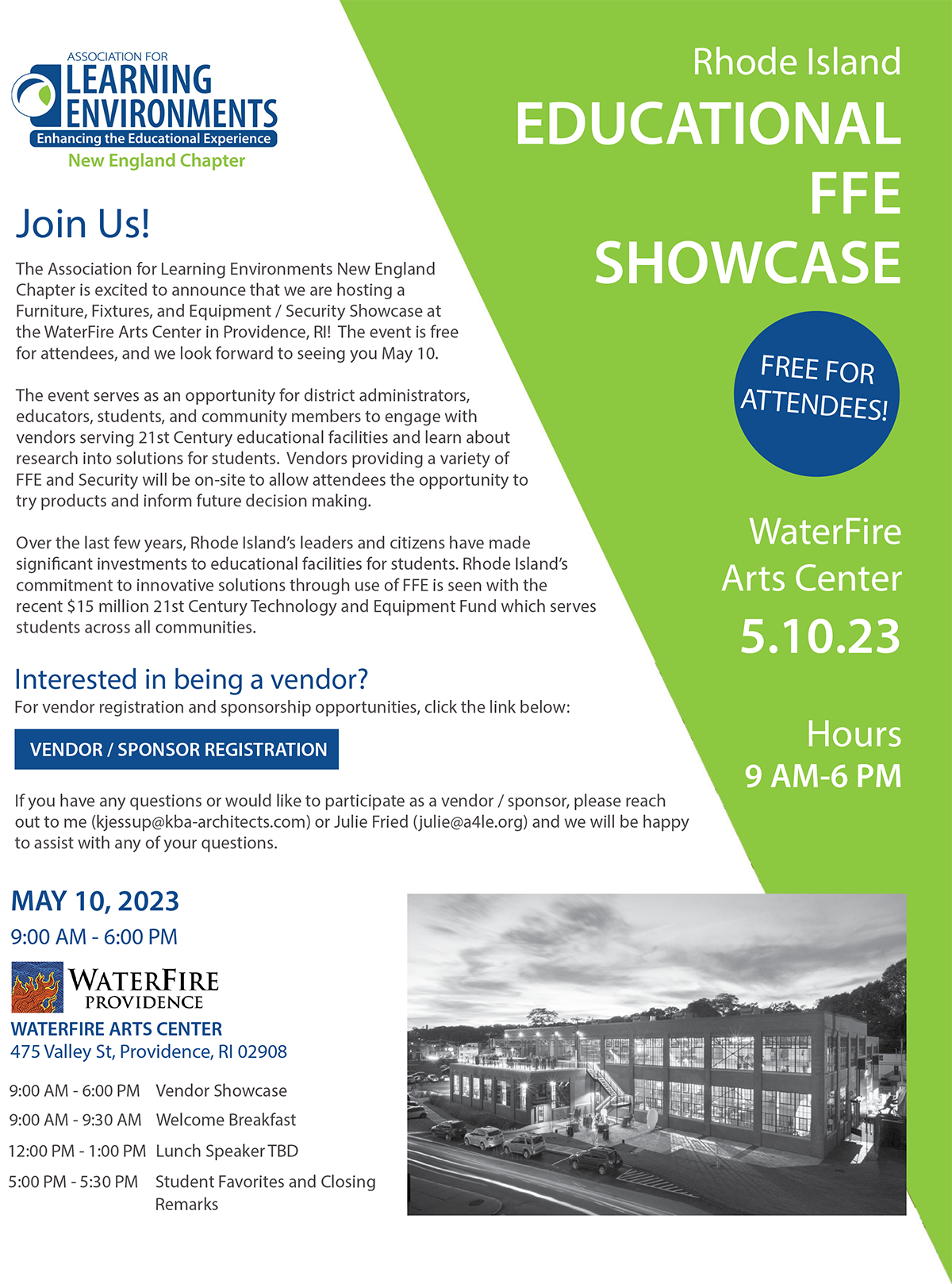 May 10, 2023
May 10, 2023
9:00 AM – 6:00 PM
 WaterFire Arts Center
WaterFire Arts Center
475 Valley St, Providence, RI 02908
Join Us!
The Association for Learning Environments New England
Chapter is excited to announce that we are hosting a
Furniture, Fixtures, and Equipment / Security Showcase at
the WaterFire Arts Center in Providence, RI! The event is free
for attendees, and we look forward to seeing you May 10.
The event serves as an opportunity for district administrators,
educators, students, and community members to engage with
vendors serving 21st Century educational facilities and learn about
research into solutions for students. Vendors providing a variety of
FFE and Security will be on-site to allow attendees the opportunity to
try products and inform future decision making.
Over the last few years, Rhode Island’s leaders and citizens have made
significant investments to educational facilities for students. Rhode Island’s
commitment to innovative solutions through use of FFE is seen with the
recent $15 million 21st Century Technology and Equipment Fund which serves
students across all communities.
| SCHEDULE |
| 9:00 AM – 6:00 PM
|
Vendor Showcase
|
| 9:00 AM – 9:30 AM
|
Welcome Breakfast
|
| 12:00 PM – 1:00 PM
|
Lunch Speaker TBD
|
| 5:00 PM – 5:30 PM
|
Student Favorites and Closing
Remarks
|
Interested in Being a Vendor or Sponsor?
If you have any questions or would like to participate as a vendor / sponsor, please reach out to me (
[email protected]) or
Julie Fried (
[email protected]) and we will be happy to assist with any of your questions.
Download PDF Flyer »
| EXHIBIT SPACE |
| Member
|
$600
|
| Non-Member
|
$650
|
Includes:
- 10' x 10' space
- The person registering the booth is NOT automatically registered for the event; please enter the name of the person who will be in attendance.
- LOAD IN INFO: TUESDAY, MAY 9, 8:00 AM – 4:00 PM.
- Booth registration includes Trade Show.
- Julie Fried will reach out when a floorplan is available.
- LAST DAY TO RESERVE A BOOTH IS APRIL 25, 2023 – ONE BOOTH PER COMPANY!
| SPONSORSHIP OPPORTUNITIES |
| Platinum Sponsor SOLD OUT
|
$750
|
| Gold Sponsor
|
$500
|
| Silver Sponsor
|
$300
|
| Bronze Sponsor
|
$150
|
Vendors
Sponsors
Platinum
Silver
Chapter Happy Hour
Friday, April 28, 2023
5:30 – 7:00 PM
Victory Brewing Company Philadelphia
1776 Benjamin Franklin Pkwy
Philadelphia, PA
We’re looking forward to seeing all of you in Philly this week. As the current New England Chapter president (again – long story), please allow me to invite you all to the New England Chapter Happy Hour so please join us... we’d love to meet you... or catch up with friends from around the country.
Sponsored by

School Tour
April 5, 2023
3:00 PM – 4:30 PM EDT
Meet at Middle School Entrance Lobby
Mountain View School
200 Park Street, Easthampton, MA, 01027
Tour Guide: Bert Gardner, Caolo & Bieniek Architects
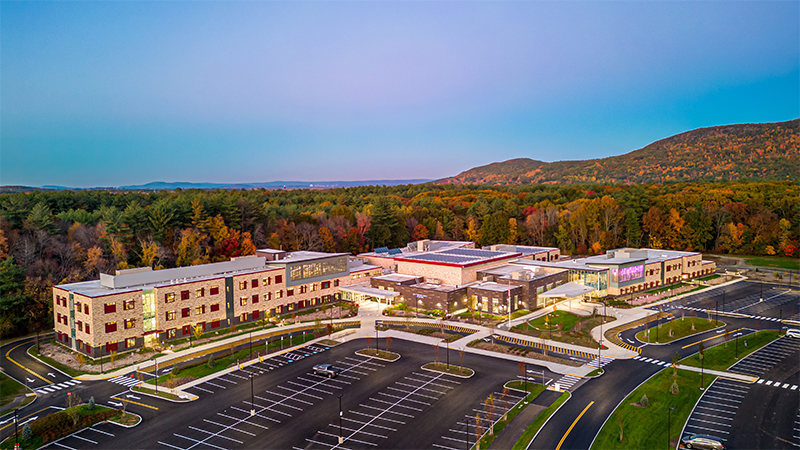
Mountain View School is a prekindergarten through grade 8, consolidated school which replaced three aging elementary schools and the city’s outdated middle school building. The tour will highlight some of the building’s key features beginning with the community’s desire for a warm, welcoming, non-institutional feel, with underlying connections to nature.
Starting at the middle school entrance lobby, the tour will discuss the overall organization of the building and the role of finishes and lighting selections, in supporting the educational plan and community vision for the school. We’ll then move to the middle school media center, where the layout supports clear sight lines and supervision, while providing flexibility to support programmatic functions, while fostering student agency. The tour will then review a typical middle school neighborhood, which integrates general classrooms, STEAM labs and breakout spaces, which support the District’s goals of hands-on learning, collaboration and cross-curricular learning. From there, the building’s shared program spaces, including the cafeterias, gymnanatorium and health services, will be reviewed, highlighting the organizational strategies developed which support both separation and organized integration of the student body, while also providing space for community functions. The tour will then move to the elementary school media center, and typical elementary school neighborhood, where we’ll discuss how design strategies were used to foster imagination, relationship building and confidence in students just beginning their educational journey. Weather permitting, the tour will then move outside to view extended learning spaces and playgrounds, which are intended to promote student mental health and wellness, through the incorporation of active and passive play, as well as quiet spaces for students who prefer some alone time in their day. Lastly, select security strategies will be reviewed to demonstrate an overall approach to delay intruders long enough for first responders to intervene.
Learning Objectives:
- Impact of lighting and material selections on occupant well-being and maintenance.
- Balancing the age gap of students with whole-school community spirit in a consolidated school.
- Maintaining a safe campus in a welcoming environment.
- Providing flexible architecture to support ever-evolving technologies and pedagogies.
Sustainable Strategies / Solutions:
High efficiency envelope, healthy building materials, solar shading, PV power/ solar hot water, and indigenous landscaping.
Innovative Strategies / Solutions:
The District was very concerned about safety, but was equally committed to providing a warm, welcoming and joyful environment for students and staff. To achieve this balance, turned to landscaping elements, such as earthen berms, seating blocks and rain gardens to separate pedestrian and vehicular traffic, protect entrances, and establish a buffer around the building.
Safety & Security Strategies / Solutions:
Several strategies are included to increase the security and safety of students and staff:
- Controlled entry,
- Clear sight lines,
- Landscaping features,
- video surveillance and
- Electronic access control to allow automated isolation of learning spaces.
Emphasis was also placed on creating a joyful environment for students of all personality types and learning abilities.
How Does the School Fit into the Community:
The project team worked closely with the planning department to ensure safe pedestrian access from neighboring park, and surrounding neighborhoods. The campus also shares access of its track, exercise circuit and playgrounds with the community.
Project Team:
Architect of Record: Caolo & Bieniek Associates, Inc.
Landscape Architect: Berkshire Design Group
Structural Engineer: Johnson Structural Engineering
Electrical Engineer: CES
Civil Engineer: Nitsch Engineering
Contractor: Fontaine Bros.
Specialized Consultants:
Early Education Consultant: Studio G Architects
Owner: City of Easthampton, School Department
Members / Public Sector: Free | Non-Members: $20
Event Sponsor: $250
School Tour
March 22, 2023
3:30 PM – 5:00 PM EDT
Meet at the main entrance of the building
Minuteman Regional Vocational Technical High School
758 Marrett Rd, Lexington, MA 02421
Tour Guide: Greg Joynt, KBA Architects
View AIA Continuing Education Systems Course »
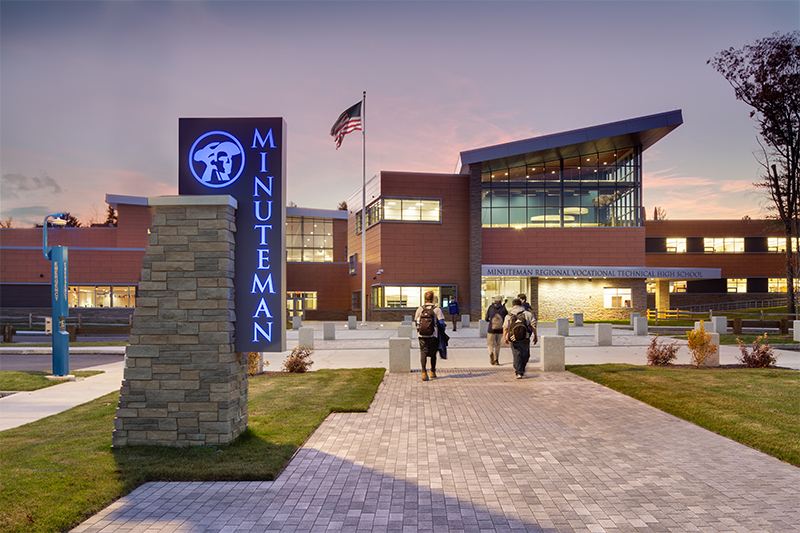
Minuteman Regional Vocational Technical High School serves 628 students in grades 9-12 from 9 sending communities. The school supports 18 CTE programs and is designed into two small learning communities which form the basis of the building design.
Learning Objectives:
- Understand career cluster curriculum model.
- Understand how the design of Minuteman harnesses the career clusters for efficiency and collaboration.
- Understand how delivery and community connections affect building layout and design.
- Learn about CTE interdisciplinary relationships supported by physical adjacencies.
Sustainable Strategies / Solutions:
The facility is LEED Silver anticipated. A secure courtyard provides sunlight, air and views deep into the school. Sustainable features include sustainable materials, enhanced rainwater management and reduced energy use. Onsite renewable energy will be generated by a photovoltaic array paired with a peak shaving battery system. The school is built on the existing site and includes an athletic complex. Exterior materials of wood and stone compliment an adjacent national park.
Innovative Strategies / Solutions:
Innovative building components include a Technology Office of Innovation Lab and breakout spaces in each academic wing to encourage collaborative learning. A multi-media engineering lab/auditorium was designed to teach operations found in a professional theater environment.
How Does the School Fit into the Community:
The Minuteman Regional Vocational Technical School District has nine member towns effective July 1, 2020: Acton, Arlington, Bolton, Concord, Dover, Lancaster, Lexington, Needham, and Stow.
Project Team:
Architect of Record & Landscape Architect: Kaestle Boos Associates Inc.
Structural Engineer: Odeh Engineers, Inc.
Electrical Engineer: BVH Integrated Services, a SALAS O’BRIEN company
Civil Engineer: Samiotes Consultants, Inc.
Contractor: Gilbane Building Company
Owner: Minuteman Regional Vocational Technical School District
Members / Public Sector: Free | Non-Members: $20
Event Sponsor: $250
Limited to 30 participants
School Tour
February 16, 2023
3:00 PM – 4:30 PM EST
Maria Weston Chapman Middle School
1051 Commercial Street, Weymouth, MA 02189
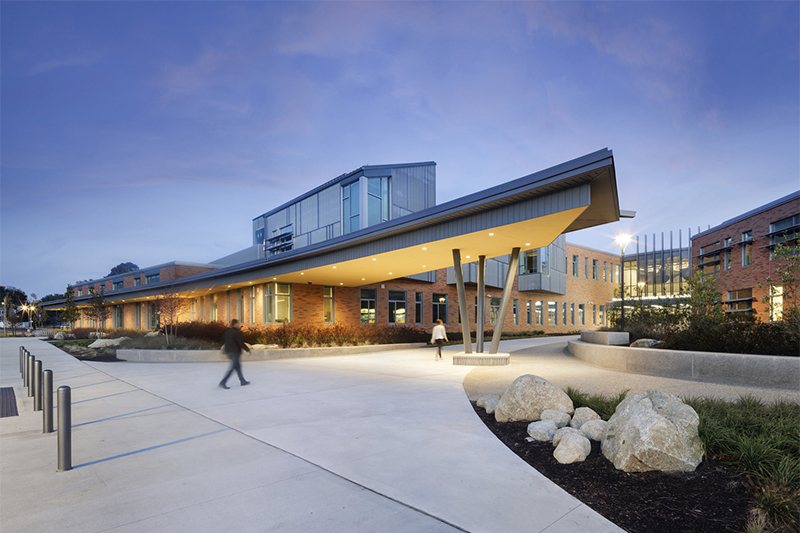
This tour will explore how a very large school can be welcoming to students and staff, and, how that school can foster smaller learning communities, encourage meaningful collaboration among staff and students, and increase social-emotional wellness for its users.
When the Town of Weymouth decided to build the largest middle school in Massachusetts, cost effectiveness and community equity were key drivers. With that direction, each student’s academic, physical, and social-emotional well-being became the central challenge of the Chapman Middle School project. We approached these issues from both an educational planning and an architectural design direction.
Small learning communities with teaching teams, consisting of two educators at 6th grade, and five at 7th and 8th grades, were the central planning unit. Each team also includes an embedded academic support teacher and classroom., Special education, including full immersion programs, is integrated within the teams, further providing equity and identity for all students. Teams are paired into two neighborhoods per grade, centered around a Neighborhood Collaborative Area, a project area fitted out for group work and self-directed learning. Each neighborhood, in turn, opens-up to a presentation area, for performance and sharing, and an outdoor classroom with seating, work surface and teaching wall, each shared by an entire grade.
In addition to the core curriculum, exploratory and elective classes are taught in state-of-the-art labs revolving around teaching themes: film production/broadcasting, culinary and nutrition, metal/wood fabrications, robotics lab/app development, expeditionary learning, theater and technical production, as well as music, art and physical education. These labs, aimed at sparking students’ interests and hooking them for lifelong learning, will serve as introductory feeders to the high school’s career tech programs.
The site was developed around whole-child needs and community access, with a half-mile walking circuit connecting age-appropriate play areas, a multi-use hard court, and fitness stations, planned to support the physical education curriculum.
Presenters:
Matthew Meehan, Chapman School Principal
James Liebman, AIA
Matt LaRue AIA
Sara Rosenthal, AIA
Members / Public Sector: Free | Non-Members: $20
Event Sponsor: $250
School Tour
January 19, 2023
3:00 – 5:30 pm
Billerica Memorial High School
35 River Street, Billerica, MA 01821
Join us for a tour of Billerica Memorial High School and see examples of Design Excellence outlined below.
Sustainable Strategies/Solutions:
We designed Billerica’s commons roof with an FSC Certified spruce timber structure (rather than conventional steel). The expressive structure is fundamental to the welcoming character of the school, but more importantly its embodied carbon will offset a typical school bus traveling over 460,000 miles.
Innovative Strategies/Solutions:
Within the central atrium/dining commons for the Billerica public high school, the team found a unique and elegant solution to two complex challenges:
- Challenge 1: Utilize a climate-specific strategy to bring daylight into a multi-story atrium at the heart of a new high school.
- Challenge 2: Integrate the required smoke evacuation system into an exposed, laminated wood beam structural system.
The team’s solution finds a synthesis between these two challenges. The process involved multiple iterative modeling paths engaging both PW’s energy lab and our smoke control modeling engineering. The detail reinforces the simple, didactic and sustainable expression of building’s tectonic.
Safety & Security Strategies/Solutions:
We all want our schools to feel open and welcoming, balancing those attributes with effective security solutions is critical to both perceived and actual community safety.
The school’s orientation and location on the site provides high visibility to all entrances of the building. The building’s layout creates a new civic green space along the north-eastern part of the school. The main central spine has full height windows to allow unrestricted views of the exterior.
The entry vestibule controls access through reception. This allows an extra level of security since each visitor must enter through the Administration suite before continuing inside the building. The smoke partitioning doubles as security gate for public use and operation.
How Does the School Fit into the Community?:
The new building will be built on the site of the existing high school, next to the existing structure. Once the new building is completed the old building will be demolished to make room for new parking and fields.
Site design provides complete accessibility to all site amenities and attributes, a challenge previously inadequately handled on the sloping site of the existing school. Inside, careful attention is paid to ensure that vertical movement through the building is an equitable experience; lifts and elevators are located along natural circulation flows, both in public spaces and in specific program areas such as the auditorium.
Learning Objectives:
- Design for Integration: Good design elevates any project, no matter how small, with a thoughtful process that delivers both beauty and function in balance. It is the element that binds all the principles together with a big idea.
- Design for Equitable Communities: Good design positively impacts future occupants and the larger community.
- Design for Ecosystem: Good design mutually benefits human and non-human inhabitants.
- Design for Water: Good design conserves and improves the quality of water as a precious resource.
- Design for Economy: Good design adds value for owners, occupants, community, and planet, regardless of project size and budget.
- Design for Energy: Good design reduces energy use and eliminates dependence on fossil fuels while improving building performance, function, comfort, and enjoyment.
- Design for Well-being: Good design supports health and well-being for all people, considering physical, mental, and emotional effects on building occupants and the surrounding community.
- Design for Resources: Good design depends on informed material selection, balancing priorities to achieve durable, safe, and healthy projects with an equitable, sustainable supply chain to minimize possible negative impacts to the planet.
- Design for Change: Adaptability, resilience, and reuse are essential to good design, which seeks to enhance usability, functionality, and value over time.
- Design for Discovery: Every project presents a unique opportunity to apply lessons learned from previous projects and gather information to refine the design process.
Project Team:
Architect of Record: Perkins and Will
Landscape Architect: Warner Larson Landscape Architects
Structural Engineer: Engineers Design Group, Inc.
Electrical Engineer: BALA
Civil Engineer: Judith Nitsch Engineering, Inc.
Contractor: Shawmut Design and Construction
Owner: Town of Billerica
Program:
| 3:00 PM |
Arrival |
| 3:15 PM |
Overview of the Project by the District and the Designer |
| 3:30 – 4:15 PM |
Tour of the Building and Grounds |
| 4:15 – 4:30 PM |
Post-tour Q&A |
Members: Free | Non-Members: $20
Event Sponsor: $250
Chapter Tour & Happy Hour
June 27, 2022
3:00 – 5:00 pm
Somerville High School
81 Highland Avenue,
Somerville, MA 02143
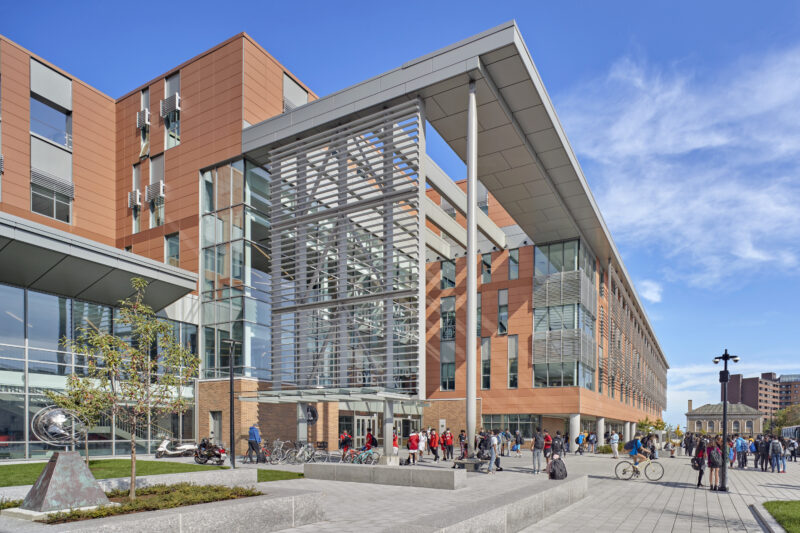
Please join us for a tour of the new Somerville High School led by Matt Rice AIA and Lorraine Finnegan AIA from SMMA.
Somerville High School occupies one of the most visible and distinctive sites in the city, perched at the apex of Central Hill on Highland Avenue. With the City, SMMA conducted a long-range master plan for the historic Central Hill to provide a foundation for integrating the future school with new recommendations for a unified civic campus. The new plan includes improved circulation, open space, pedestrian movement, parking, and connection points with the new Gilman Square GLX stop. It also forms a relationship between the site’s buildings. The new high school entrance establishes an education concourse on the east side of Central Hill with the Central Branch Library, and City Hall and the future 1895 Annex creates a municipal/civic concourse on the west side.
Somerville High School is a comprehensive high school designed for 1,590 students and is approximately 396,000 SF in area. In addition to its full complement of academic programs, it houses 14 CTE programs, the district’s alternative middle school and high school, a teen health center, a functioning day care, the City TV broadcast studio and a teen health center.
All attendees must be masked when in the building.
Happy Hour following the Tour:
Tony C’s Sports Bar & Grill
699 Assembly Row, Somerville, MA 02145
BSA Members: Free | General Admission: $10
Virtual Event
May 18, 2022
4:30 pm – 90 minute session
The Power of Student Voices in School Design and Construction
Please join us in hearing from three design firms as they highlight the power of incorporating student voices into the school design and construction process.
Dawn Guarriello, Perkins Eastman
Dawn will showcase a case study for the Blanche A. Ames Early Elementary School (Grades PK-2 ) in Easton, MA. Although they will never formally learn within in the walls of this building once it’s complete, current Oliver Ames High School students have already learned (and taught) tons about speaking up, being heard and the importance of student voices. This group of students was included in the building design process and proposed ideas about how the building can highlight the history of Easton and the Blanche A Ames legacy. Dawn will speak to the specifics of their ideas and the implementation in the building design and how this collaboration created a better school for the future PK-2 students in Easton.
Christina Bazelmans, LPA|A
Christina will review a case study at Doherty Memorial High School, where the Design and Construction teams have partnered with local educational institutions to transform the construction site of a prominent Worcester High School into a “Living Lab” accessible to students throughout the region. Through curriculum integration, presentations, and site visits, local high school and university students are invited to explore opportunities in the Architecture, Engineering and Construction fields. The behind-the-scenes inclusion in the construction of a state-of-the-art educational facility in their own community offers firsthand experience to students who have been historically underrepresented in these industries.
Jason Boone, Dore and Whittier
D+W believes students can be (and perhaps should be) the most powerful influencers on school design projects. D+W will share three examples of student engagement on three different projects with an emphasis on the process and tools utilized as well as the outcomes. The first example comes from our Gates Middle Schools project, where students participated in a design charrette early in the Preferred Schematic Report phase. Using a set of graphic tools and inspirational imagery, students were instrumental in shaping the geometry, levels of transparency, and functionality of grade level teams that would eventually get built. In the second example, Pentucket Regional middle and high school students participated in a design charrette and used largely furniture templates, trace paper, and floor plans in the design development phase to create new concepts for student dining and lockers that will be occupied this fall. The third example is from a current project that will house 5th-8th graders. Students were invited to use develop ideas for the cafeteria and outdoors. Students used primitive drawing and modeling tools to create concepts that are now being incorporated into the schematic design.
Members / School District Personnel: FREE | Non-members: $20
Sponsorships: $250
Educators Roundtable
Wednesday, February 16, 2022
4:00 pm Eastern
Synopsis
What can be learned at the intersection of curriculum, instruction, learning, and the learning environment? Come find out in this educator roundtable, as we hear from educators and educational leaders throughout New England about their daily work with curriculum and students and how the learning environment elevates or impedes those experiences. This moderated conversation will cover a variety of topics including, but not limited to:
- Recently built environments – What’s working? What’s not?
- Collaboration, group work, and movement through the various grades
- STEM / STEAM
- Social/Emotional Learning & Mindfulness
Participants will also have the opportunity to ask questions related to the built environment, teaching, and learning.
Learning Objectives:
- Understand the different ways design has an impact on learning and behavior.
- Learn about different ways the classroom and building features help students to collaborative more effectively.
- Learn what features, amenities, and spatial adjacencies are most important to support the interdisciplinary opportunities for STEAM related curriculum.
- Understand what social/emotional learning and mindful practices look like at various grades levels and how the physical leaning environment can help or hinder these efforts.
Members / School District Personnel: FREE | Non-members: $20
Sponsorships: $250
Chapter Event
November 12, 2021
12:00 – 1:00 PM Eastern Time
Is there a need for a Makerspace in your school? How about a Fab Lab that supports the entire community? These types of spaces have caught the attention of educators and municipal administrators across the spectrum. However, the process of converting idea to reality is not simple. The Makerspace concept of a partial warehouse conversion somewhere in town where adults spend evenings working on their special projects with help from kindred spirits and shared equipment is undergoing an amazing transformation. Known as Fab Labs, Da Vinci Labs, Hackerspaces, or just plain Makerspaces, they are becoming irresistible places where people learn by doing. Designed and equipped to meet the teaching and learning needs of young people from kindergarten to college and beyond they are properly developed in schools in the U.S., Europe, Australia, and elsewhere. But the journey is fraught with roadblocks and hurdles; not all of which can be overcome. Join us on a journey through some of the exciting things that educators, architects, and community leaders are doing as we share important considerations, and lessons learned, in funding, designing, and equipping a Makerspace.
Learning Objectives:
- To identify at least three educational objectives that Makerspaces are commonly used for.
- Follow a process for collecting essential school and community information to enable the design of highly effective Makerspaces and be able to develop a similar plan.
- Learn about a successful Makerspace program that engaged multiple key stakeholders from a school district, municipal government, businesses, nonprofit agencies, and local colleges; and they will be able to explain the relationships of the major constituent elements.
- Understand the factors that contribute to a failed funding effort and what can be can be done after a project effort fails.
Speakers

|
John Tindall-Gibson, Ph.D., ALEP
John’s 30+ years as an educator provide a wealth of experience to draw from as Educational Programmer for DRA Architects. He has worked as a high school teacher, K-8 and middle school administrator, and superintendent in Arizona, Rhode Island, and Connecticut. He has also taught courses at the community college and graduate school levels and presented at national education conferences.
|
|
|

|
Gregory Smolley, AIA, APA, LEED, ALEP
As Project Manager and Studio Director for DRA Architects, Greg is a leader in the design and master planning of educational facilities throughout New England. His 28 years of experience includes a wide variety of educational projects for both public and private clients ranging from early childhood centers to high schools and collegiate projects. He has led numerous school projects spanning from renovation and reuse of many historical buildings and school facility studies to large, complex, multimillion dollar additions and new construction.
|
|
|
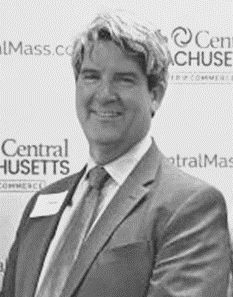
|
Philip Duffy
Philip Duffy is the Community & Economic Development Director for the Town of Clinton, MA, population 13,606. In that capacity, he is responsible for a range of programs and projects, including small business support, infrastructure and public facilities improvement, downtown revitalization, brownfields remediation, social services, and housing rehabilitation.
|
Members: Free | Non-Members: $20
Sponsorships: $250
Virtual Tour
May 14, 2021
12:00 pm Eastern
Lincoln School, Providence, RI
Presenters: Kathleen Bartels, AIA & Christian Ladds, AIA, LLB Architects
The conversion of the science wing to a STEAM (Science, Technology, Engineering, Arts/Architecture, and Math) Hub sits at the intersection of several of the key guiding principles of the Lincoln School Master Plan developed by LLB in 2016. It presented an opportunity to recast traditional classrooms as dynamic spaces for group collaboration and project-based learning, improve flow and functionality, and reintroduce Lincoln School as a powerhouse educator of girls.
The design of the two-story, 4,000 sf addition is very modern; a visual expression of the school’s mantra ‘where tradition meets innovation.' It features a dramatic glass curtainwall with 20 vertical fins, or sun shades, spaced in such a way as to create rolling shade as the sun moves. The modern, curvilinear design allows people outside to literally look through the new addition and see the adjacent historic gymnasium.
Members FREE | Non-members $20
Virtual Tour
March 12, 2021
12:00 – 1:00 PM Eastern Time
Eliot Innovation School
The Eliot Innovation School at 585 Commercial Street serves grades 5-8, and is part of a three-building campus in Boston’s North End. The project involved the transformation and adaptive reuse of a former FDA testing facility turned office building, into a contemporary educational facility. The program includes: classrooms, cafeteria, breakout nooks, a media center, co-located robotics technology and art classrooms. Additionally, spaces are provided for various teaching specialists who move between the multiple Eliot Innovation School locations.
The extensive renovation promotes student engagement and collaboration at every turn. Grand views and thoughtful details bring classrooms, art and technology spaces, and a media center make the entire building a space for learning. History plays a significant part in the design as large windows frame the Boston Harbor, Zakim Bridge, Old North Church and the USS Constitution.
Learning Objectives:
- Understand the complexities surrounding the educational program for the Eliot Innovation School which consists of 3 school buildings on 1 site in the City of Boston.
- Understand the process of transforming an existing building that has served many purposes before being converted to an educational facility.
- Learn about the construction challenges of building adjacent to Boston Harbor
- Highlights from the Post-Occupancy Evaluation to learn what works best and what can be modified to meet the educational needs.
Members: FREE | Non-members: $20
Virtual Tour
February 12, 2021
12:00 – 1:00 PM Eastern Time
Saugus Middle / High School
Sited along bustling Route 1, and near the historic Saugus Iron Works, the new Saugus Middle/High School supports forward-thinking education and celebrates the town’s rich history of innovation. The 271,000 sf facility brings together 1,360 middle and high school students in a STEAM-driven complex of fabrication labs, collaboration spaces, and project areas that offer hands-on opportunities for exploratory learning. Grade-level classroom pods establish small learning communities within the school, each featuring a clear identity reinforced by dynamic and colorful super graphics honoring Saugus’ pioneering industries in ice, iron, and lobstering. Multi-story lightwells provide a visual connection between grade levels to foster a sense of shared space and experience, helping the next generation of students to learn and grow.
Members FREE | Non-members $20
Last day to register is February 11 at 9:00 PM Eastern
Sponsored by:

Monthly Design Shares

Please join the New England Chapter for the first installment of monthly design shares on the second Friday of each month at Noon!
At the A4LE 2012 World Congress on Education, Ron Lamarre of Lavallee Brensinger Architects presented a concept for the Classroom of the Future based on the thesis of
Anytime, Anywhere Learning. Years later, William Gould of ARTiK Art & Architecture presented
Shifting the Paradigm: A Vision for Learning in 2035 at the A4LE 2018 LearningSCAPES Conference. Both concepts consider the power of technology and the role it plays in our current and future learning experiences. Amidst the 2020-21 COVID Pandemic educational planners are taking an active role in redefining the learning environment to consider health and wellness while continuing to elevate educational outcomes.
Join our New England Chapter, in cooperation with the BSA K12 Educational Facilities Committee, as we present ARTiK Art & Architecture's video thesis on Schools of the Future emphasizing Anytime, Anywhere Learning – from Anyone for Everyone.
Schools of the Future – Design Presentation
January 8, 2021
12:00 PM Eastern Time (US and Canada)
February's presentation will include a tour by HMFH Architects led by Tina Stanislaski and Gary Brock on February 12 at Noon. Details to follow.
Zoom Discussion
August 13, 2020
4:00 PM
View presentation »
Access Passcode: pGJjz!5P
Chapter Members,
Thank you for everyone who participated in the Zoom Happy Hour and Discussion about CTE/CTC and Vocational Education. A special thanks for HMFH and Kaestle Boos Associates for sharing two exciting projects. Once we can meet in person, I look forward to touring these two projects! If you missed our call, please feel free to review the presentations in the Members Forum for the New England Chapter in the Library
here.
Outdoor Learning Environments Project Share
Modernization of the Garrison Elementary School, completed in 2017, aimed to upgrade facilities and create a nurturing learning environment. It was focused on fortifying fundamental relationships already embedded in the school's plan – between building and street, building and schoolyard, and building and student. Garrison Elementary serves a diverse, highly involved community that advocated fiercely for the school. We prioritized community engagement to produce a school which reflected the community's identity and aspirations – both indoor and outdoor.
Architects: BELL and Newman. Landscape Architects: LAB.
Learning Goals:
- Understand several current best practices in outdoor learning environment design
- Understand several of the most pressing practical concerns in outdoor learning environment design
- Understand the process of integrating best practices and practical concerns in outdoor learning environment design
- CEU will be offered
Register in advance for this meeting:
Future discussion topics will include:
- Safety and Security
- Special Education
- FFE
If you have a project you would like to highlight, please reach out to
[email protected].
I look forward to seeing you all next month.
Kate
Zoom Happy Hour
Thursday, June 11, 2020
4:00 pm – 5:00 pm
Please join the New England Chapter for a Zoom Happy Hour!
Meet your leaders, provide input on future events, and discuss topics of interest and challenges with A4LE peers. We encourage all of our chapter members to join us for this event and engage with the chapter.
POSTPONED – Chapter Tour
Tuesday, March 24, 2020
4:00 PM
Eliot Innovation School
585 Commercial Street, Boston, MA 02109
Antico Forno
93 Salem Street, Boston, MA 02113
This is a free event. Please RSVP.
Please join the New England Chapter on March 24th at 4:00 pm for a tour of Eliot Innovation School in Boston’s North End followed by a social gathering at the Antico Forno.
The
Eliot Innovation School serves grades K-8 and in a 3-building city campus that serves over 700 students. The tour will take place at the recently completed facility that serves grades 5-8 which features 18 classrooms, a cafeteria, four breakout nooks, a media center, co-located robotics technology and art classrooms and dedicated storage for musical instruments, as music instruction is done with teaching specialists within the classrooms. Additionally, spaces are provided for various teaching specialists who move between the multiple Eliot Innovation School locations.
Please note, there is a Bruins game later that evening so special event parking rates apply at many of the nearby parking garages. It is recommended to use public transportation or park just north of Boston at Assembly Row in Somerville and take the Orange Line three stops to North Station.
Chapter Tour
January 30, 2020
4:00 PM
Salem High School and Career Technical Education
44 Geremonty Dr., Salem, NH 03079
Copper Door in Salem
41 S Broadway, Salem, NH 03079
This is a free event. Please RSVP.
Please join the A4LE New England Chapter for a tour of Salem High School and Career Technical Education followed by a social gathering at the Copper Door in Salem.
The 50-year old comprehensive Salem High School and Career Technical Education Center has been expanded and integrated to provide 1,200 students with a state-of-the-art educational environment. Core academic, performance, art, and music areas have been blended with CTE programs of Biotechnology, Television Productions, Veterinary Sciences, Automotive Technology, and Computer Aided Design; as well as extra-curricular programs of AFJROTC, Journalism, Filmmaking, Drama, Health Occupations, Debate, and Athletics.
Chapter Tour
October 15, 2019
4:00 PM
Perry and Marty Granoff Center for the Creative Arts
154 Angell Street
Providence, RI 02906
Flatbread Company
161 Cushing Street
Providence, RI 02906
Please join the Association for Learning Environments and AIA Rhode Island for a tour of the Perry and Marty Granoff Center for the Creative Arts followed by a Social Gathering at Flatbread Pizza.
The Perry and Marty Granoff Center for the Creative Arts at Brown University is a 38,815 square-foot, three-story, interdisciplinary arts center at the heart of the College Hill campus, designed by Diller Scofidio + Renfro.
The facility is an interdisciplinary arts center that fosters innovation, research, collaboration, creativity, and education among the arts, humanities, and sciences. The facility embodies the educational philosophy at the heart of Brown University which emphasizes cross-departmental teaching and learning and interdisciplinary collaboration. The building serves as a physical manifestation of the educational pedagogy and the University’s commitment to excellence.
The tour is open to all and hosted in collaboration between Association for Learning Environments New England Chapter and AIA Rhode Island.
This is a free event. Please RSVP.
Chapter Event
Tuesday, June 25, 2019
4:00 – 6:00 pm
Steelcase Showroom Boston
101 Seaport Boulevard, Suite 600
Boston, MA 02210
Educator Panel Discussion: Challenge Accepted, Using Architecture to Address the Educational Challenges of the Future
This is a FREE event, please RSVP!